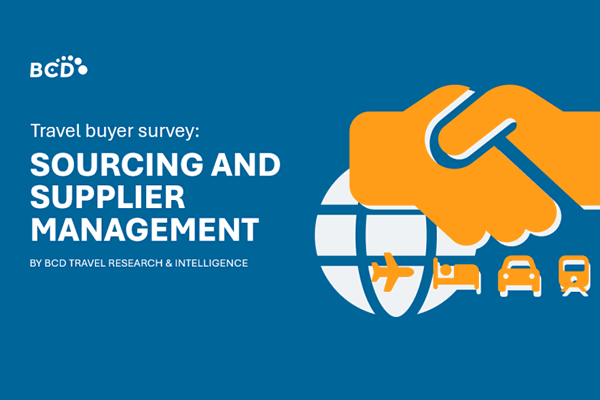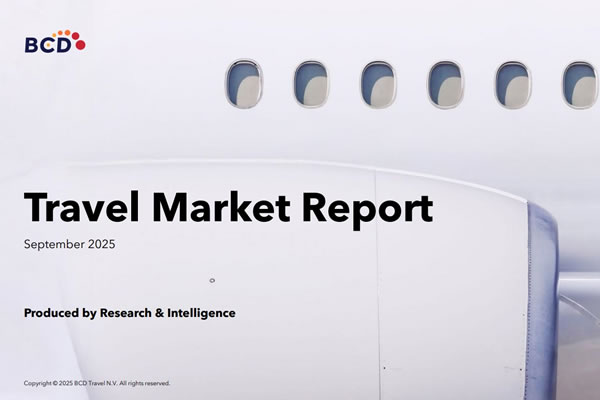Published: September 2025
Produced by Research & Intelligence
By Mike Eggleton, Natalia Tretyakevich, Melina Sibaja
This quarter’s Travel Market Report begins with a summary of the International Air Transport Association’s (IATA) latest outlook for the airline industry in 2025 and compares it to the predictions for this year it had previously made in its December 2024 outlook.
Sticking with airlines (and IATA), we present an update on the performance of the global airline industry so far this year.
The new U.S. administration has been busy implementing multiple immigration rule changes aimed at improving the control and security of its borders. We provide a summary of some of the key developments.
We’ve conducted some detailed primary research among a panel of travel buyers. We share their main insights about sourcing and supplier management.
We finish this quarter’s report with the highlights of a recent traveler survey, in which we learnt more about their experiences and preferences when booking accommodation for a business trip.
Update on global airline traffic
North America weighing on global growth, but latest numbers more positive
At 4.0%, July’s increase in global airline traffic meant a third consecutive month of 3-5% growth.1 After the disruption caused to year-over-year comparisons by Easter’s later timing in April, a market trend is now emerging of steady growth, albeit at around half of 2024’s level. Domestic demand increased by just 1.9%, with international demand growing by 5.3%, rebounding from June’s 3.2%.
In the first seven months of 2025, airline traffic grew by 5.0%, combining 2.1% and 6.9% growth from domestic and international traffic, respectively. Emerging markets drove this growth, with Asia Pacific leading the way with an 8.3% expansion in demand. Latin America (7.6%) and Africa (6.7%) also outpaced the global average.
Even the mature European market has performed reasonably well so far this year, with 4.4% growth falling just short of the global number. And the Middle East, where traffic has been disrupted by geopolitical events, posted growth of 5.1%. This leaves North America as the standout region, with airline traffic being essentially flat so far this year, weighing on global growth. And yet, after setting aside the effects of the later timing of Easter, the monthly numbers provide some reason to be more positive about the North American situation. After dipping by 0.5% in May, traffic was flat in June and expanded by 1.9% in July, its strongest performance since January. This largely reflected an improved contribution from the all-important U.S. domestic market, where a five-month run of weak numbers ended with July’s 1.5% expansion. Growth also returned to the region’s international airline traffic.
Regional perspective
In 2025’s first seven months, domestic air travel demand rose by just 2.1%. However, some major markets, including Brazil and India, defied the malaise implied by such a low number.
Even the 4-6% growth in China and Japan was above a global average, which was depressed by continued weakness in the U.S., where traffic dipped by 0.3%.
This weakness was echoed by July’s total traffic numbers for the different regions.
In a month when global airline traffic increased by 4.0% year-over-year, demand in North America rose by 1.9%. While this improved on recent months, it was still below the 2.9% delivered by Europe, a similarly mature market.
Growth stayed strong in Asia Pacific and Latin America and rebounded in the Middle East.
U.S. immigration rule changes
U.S. government tightening entry requirements
During 2025, U.S. government departments have been acting to reinforce the control and protection of the country’s international borders. This has implications for business travelers and travel programs, which must navigate new rules and added complexity.
On June 9, the U.S. government reinstated and expanded a travel ban impacting nationals of 19 countries. This was justified on national security grounds relating to terrorism concerns, inadequate vetting and high visa overstay rates. Nationals from 12 “very high-risk” countries are now barred from entering the U.S.: Afghanistan, Chad, Republic of Congo, Equatorial Guinea, Eritrea, Haiti, Iran, Libya, Myanmar, Somalia, Sudan and Yemen. Both immigrant and non-immigrant visas are fully suspended. A further seven countries are subject to partial bans. Specific visa categories have been suspended for nationals from Burundi, Cuba, Laos, Sierra Leone, Togo, Turkmenistan and Venezuela. Importantly, the restrictions bar most visa types used by business travelers. It is possible to seek a waiver or an exception, but this must be done during the visa application process. Exceptions may be made if a traveler’s entry to the U.S. is in the national interest, the traveler poses no security threat, or denial of entry would cause undue hardship. In reality, travelers from a banned country now have limited options, if they want to visit the U.S.
To address concerns about countries considered to be of a lower risk, but with high visa overstay rates or limited identify verification procedures, the U.S. has introduced a 12-month visa bond pilot program, starting August 20. So far, the scheme applies only to nationals from two countries, Malawi and Zambia, but other countries could be added. Critically, the pilot program seems unlikely to affect travelers from Visa Waiver Program (VWP) countries. Business travelers, who are citizens or nationals of 42 designated countries,2 including 32 in Europe, as well as Australia, Brunei, Chile, Israel, Japan, New Zealand, Qatar, Singapore, South Korea and Taiwan, should be exempt. Currently, business travelers with passports issued by Malawi and Zambia may be required to pay a $5,000, $10,000 or $15,000 bond, which will be forfeited if the terms of the visa are violated. Such visas are valid for single-entry only, cover stays of up to 30 days and require entry/departure via Boston Logan International, New York JFK or Washington Dulles International airport.
From September 2025, the U.S Department of State suspended the Dropbox Program, which provided an interview waiver for many non-immigrant visa applications and renewals. While limited exemptions exist, nearly all non-immigrant visa applicants must present themselves for an in-person interview at a U.S. consulate in the country of their nationality or residence. Interviewees have lost the option of being interviewed in any other country, where processing times might be shorter. For nationals and citizens of more than 50 countries, mainly in Africa, the rules are even stricter, with all applicants required to attend in-person interviews.
What this means
Travel bans and the conditions imposed on travelers affected by the visa bond program add new complexity for international business travel, particularly for organizations relying on talent mobility and cross-border collaboration. In-person meetings, training and project-based work in the U.S. will no longer be possible for some workers. Companies will need to consider remote alternatives or redeploy personnel from third countries to maintain operations. With nearly all visa applications and renewals now requiring an in-person interview, companies must plan an earlier start for any visa processing. Employees may need extra time to prepare for and attend interviews. Even where travel is still allowed, companies may expect additional layers of planning and risk management for their employees.
Added to the indirect costs associated with these changes, the U.S Customs and Border Protection (CBP) agency has announced a September 30 fee increase for travelers able to take advantage of the Electronic System for Travel Authorization (ESTA).3 Visitors from visa-waiver countries, including most E.U. member states and the U.K., face a jump in the ESTA fee from $21 to $40. While the travel promotion fee part of the ESTA is unchanged at $17, the operational fee has increased from $4 to $10, and the One Big Beautiful Bill Act has introduced a new $13 Treasury General Fund fee.4 The cost of an ESTA had previously increased in May 2022 from $14. ESTA authorization remains valid for two years, unless a traveler’s passport expires beforehand.
Sourcing and supplier management: travel buyer survey
Travel buyers share their experiences when sourcing and managing travel suppliers
In this survey, we looked at how organizations source and manage travel suppliers. We focus on procurement strategies, key challenges, priorities, and supplier management trends that influence travel program performance. Our findings are based on an online survey of 132 travel buyers worldwide, conducted in April 2025.
Our findings, at a glance
Sourcing priorities
Savings and cost control is the top priority for travel buyers when it comes to sourcing and supplier management: Nearly nine out of 10 agreed. Around one-third of buyers prioritize data collection, compliance control and supplier consolidation to increase leverage.
Sourcing tasks
Contract negotiations and management topped the list ofthe most time-consuming tasks related to supplier sourcing and management, cited by over half of respondents. Around four out of 10 pointed to managing Requests for Proposals (RFP) and monitoring supplier data and performance as significant time investments.
Challenges
Top sourcing concerns include high costs and rate fluctuations, cited by over 40% of respondents. Among other frequently mentioned issues, travel buyers mentioned fragmented content, the complexity of the RFP process, and technological shortcomings. Additionally, one in five would like to have a broader selection of suppliers to choose from.
Frequency of contract negotiations
Travel buyers shared insights on how often they negotiate contracts with their travel suppliers, revealing notable differences across the categories. Hotel agreements stand out for their consistency, with 87% being renewed annually. In contrast, airline and car rental contracts tend to be of longer duration. Agreements with travel management companies (TMC) are more mixed, lasting mostly between 2 and 5 years.
Cost containment measures
Cost reduction is the top priority and greatest challenge for travel buyers related to sourcing and managing travel suppliers. To address this, buyers employ a range of strategies aimed at lowering supplier costs. The most commonly used approaches, each adopted by approximately 40–50% of buyers, include supplier consolidation, renegotiation of existing agreements and the use of re-shopping tools.
Looking ahead, buyersconsider renewing supplier agreements for longer time periods, re-negotiating existing contracts and issuing new requirements.
Sourcing trends
Buyers anticipate an increased use of artificial intelligence, moremulti-year agreements, continuous sourcing and supplier and platform consolidation to be among the major supplier management trends in the upcoming years.
FIND OUT MORE
We’ve highlighted just some of the key findings from our travel buyer survey on sourcing. You can find out much more detail in the full report that we’ll be publishing soon.

Hotel booking trends: traveler survey
Business travelers share their experiences and behaviors when selecting accommodation for business trips
In this survey, we explored traveler choice ofhotelsandother types ofaccommodationwhen traveling for business, as well as their bookingbehavior and experience during their stays. The results are based on an online survey of 1,035 business travelers in North America, Europe and Asia Pacific, conducted in May 2025.
Our findings, at a glance
Booking accommodation
While over four out five travelers book accommodation via an online booking tool (OBT), one in five use supplier websites. Nine out of 10 book on a desktop/laptop; only one in 10 use a mobile phone to reserve a hotel stay.
Corporate credit card is by far the most popular method of paying for accommodation with three-quarters using it.
Factors influencing accommodation choice
Location plays a major role in influencing travelers’ hotel selection: Three-quarters of respondents consider it important. Their employer’s policy and price are also in the top-three. A traveler’s past experience, the property’s brand and participation in a loyalty program are also significant for many. Sustainability is at the bottom of the list, being mentioned by just a few travelers.
Challenges when booking accommodation
Insufficient hotel rate limits set by the employer is the biggest challenge travelers face when booking accommodation. One in three see no significant issuesduring booking process.
Hotel loyalty programs
A significant 80% of surveyed business travelers are members of hotel loyalty programs. This figure is even higher in North America, where 99% participate in such programs. In contrast, participation in Europe and Asia Pacific is lower, at 70% and 58%, respectively.
Across the global sample, three-quarters of travelers are members of multiple hotel loyalty schemes, and two-thirds frequently stay at hotels affiliated with the programs they support. When it comes to retaining points earned from accommodation on business trips,75% of travelersreport that their employers allow this.
Sustainability
While 16% of travelers consider environmental factors when booking accommodation, half never or rarely take sustainability into account. Four in 10 travelers do not consider any sustainability attributes when booking accommodation. Meanwhile, one in five look for green features such as eco-certifications, the absence of single-use plastics, low emissions, reduced water consumption and limited housekeeping.
Bleisure
Six travelers out of 10 occasionally combine business trips with leisure. Four out of 10 may bring their partners, family, or friends on business trips, though most rarely do so.
FIND OUT MORE
These are just a few of the key findings from our survey. You can find out much more detail in the full report.

Share your thoughts
Do you have any questions or comments regarding this report? Please email Mike Eggleton to share your thoughts.
